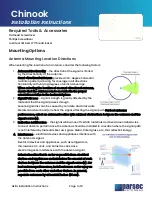
locations on the antenna’s surface, these supports should accurately position
the feed at the correct focal length: the distance between the center of the dish
and the opening of the feedhorn. The correct focal length for your dish is
provided in the manufacturer’s assembly manual.
Once your system is up and running, you can fine tune the focal length for its
optimum position by moving the feed in and out in small increments while
watching the receiver’s signal strength meter. This is easier to do with a button
hook than a quad support. This adjustment is particularly important if you are
having trouble receiving Ku-band satellite signal.
You can compute the focal length if you know the diameter of the dish along
with its f/D ratio. Focal length = the antenna diameter times the f/D ratio. For
example, the focal length of a 10 foot antenna with an f/D ratio of .45 equals 10
x .45 = 4.5 feet (54 inches).
To determine the antenna’s diameter, measure across the surface of the dish
from one side to the other. The radius equals one half the diameter. The depth
of the dish is the distance from the center of the dish to the plane of the rim.
Stretch a string across the antenna’s rim so that it crosses in the center of the
dish. The depth will be the distance from the antenna’s center to the string.
Many feeds today have adjustable scalar rings. These feeds can be broken
down into two parts: a round flat “scalar” plate with concentric circles on its
surface and the wave guide onto which the LNB is mounted. This wave guide
fits into the center of the scalar plate and can be adjusted inward and outward.
The distance that the wave guide extends beyond the surface of the scalar
plate must be set correspond to the f/D of the antenna. Consult with the
manufacturer’s assembly directions or use the formula provided above to
determine the correct f/D ration of your antenna.
The wave guide may be marked to indicate the various f/D ratio settings.
Alternatively, the feedhorn may come with an adjustment gauge for setting the
correct location of the scalar rings.
Another thing to check: the plane of the feed opening should be the same as
the plane of the rim of the dish. You can use your inclinometer to check to be
sure that both the feed opening and the antenna’s rim are parallel with each
other.
Running The Cable
In most cases it will take three sets of wires to hook up your system: the
coaxial cable from the LNB to the receiver, a three conductor wire from the
servo motor of the feedhorn to the servo motor control on the back of the





























